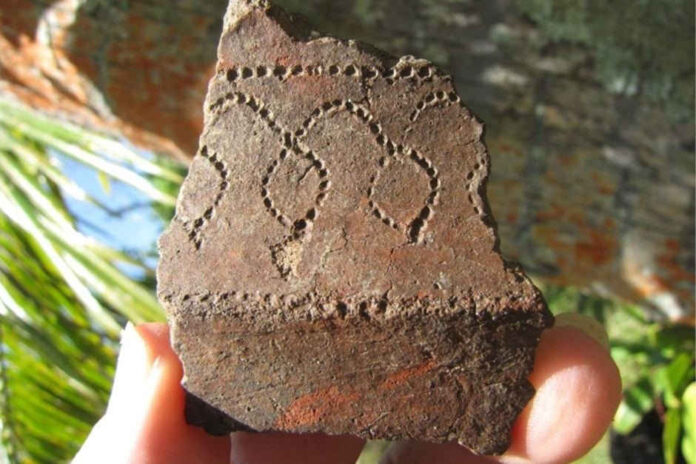Lapita pottery, characterized by its unique earthenware style, stands as a pivotal archaeological artifact in unraveling the prehistory of the Pacific Islands.
This article delves into the various facets of Lapita pottery, including its defining features, historical context, production methods, geographical spread, and the insights it offers into the ancient cultures of the Pacific.
Characteristics of Lapita Pottery
The most striking aspect of Lapita pottery is its complex geometric patterns, stamped into the clay. This technique distinguishes it from other ancient pottery styles. The designs, often circles, dots, and hatching, are thought to be symbolic, though their precise meanings are still debated by archaeologists. The shapes of the pottery are also unique, commonly seen in forms like bowls, dishes, and pots with flat bases and rounded bodies.
As the rest of Tonga rebuilds, Sio Siasau & Serene Tay have resumed eruption-disrupted work on their community art studio. As they dig for clay by Fanga’uta lagoon, the past passes them messages written on midden shells & shards of ancient Lapita pottery. pic.twitter.com/KzbriTML6Z
— Scott Hamilton RTM (@SikotiHamiltonR) April 2, 2022
Historical Background and Significance
Dating back to around 1500-500 BC, Lapita pottery is named after a site in New Caledonia where it was initially discovered. Its historical importance lies in its widespread distribution across the Pacific, highlighting the ancient Pacific peoples’ extensive sea voyaging and trade networks. The spread of Lapita pottery is intimately linked with the Austronesian expansion, a significant migratory event believed to have facilitated the settlement of the Pacific Islands.
The ‘Lapita’ Pottery and its decoration#Pacific #Lapita #FijiHistory pic.twitter.com/dQcHcfNYf0
— The Fiji Museum (@FijiMuseum) July 19, 2021
Production Techniques
The production of Lapita pottery sheds light on the technological skills of its creators. Local clay was the primary material, and the pottery was crafted using a coil-building method. The pots were then adorned with designs using stamps made of bone, shell, or wood. This careful and skillful execution of motifs indicates a high degree of artistic ability. The pottery was fired in open or semi-open fires, a common practice in many ancient cultures, rather than in kilns.
Distribution and Trade
Remarkably, Lapita pottery is found across the Pacific Islands, from Papua New Guinea to Samoa and Tonga. This wide distribution evidences the far-reaching voyaging capabilities of the Lapita people. The consistency in pottery styles over great distances suggests a shared cultural heritage and possibly a common language. The dispersion of this pottery has also been instrumental in tracing ancient Pacific migration routes and trade networks.
Insights into Ancient Pacific Cultures
Lapita pottery provides invaluable insights into its makers and users. The complexity of the designs implies a society with specialized craftsmen and a well-developed social structure. The motifs and shapes likely held cultural or religious significance, offering a glimpse into the beliefs and practices of these ancient peoples. Furthermore, the extensive distribution of the pottery indicates a society that was mobile, adventurous, and proficient in maritime navigation.
Archaeological Excavations and Discoveries
Archaeological digs at Lapita sites have unearthed not just pottery but also tools, ornaments, and food remains, offering a more comprehensive view of Lapita culture. These discoveries have enhanced our understanding of their daily life, diet, and social organization. The stratification at these sites also provides insights into the chronological evolution of Lapita culture and its interactions with contemporaneous cultures.
#FridayFinds: Recently reminded of this one – beautifully decorated #Lapita pottery from the Reef Santa Cruz group, #SolomonIslands. Image source: https://t.co/GoJbIgaGMs #archaeology pic.twitter.com/cpYT5R7OuN
— Nick Sutton (@NickPSutton) February 28, 2019
Comparative Analysis with Other Pottery Traditions
Comparing Lapita pottery with other pottery traditions from the same era worldwide reveals similarities and differences in artistic expression, technological advancement, and cultural significance. Such comparisons shed light on the extent of intercultural exchanges and influences in the ancient world.
Preservation and Conservation Challenges
Preserving Lapita pottery is fraught with challenges. Many sites are in areas prone to erosion, volcanic activity, and other natural hazards. Additionally, the growing impacts of climate change, such as rising sea levels and increased storm frequency, pose significant risks to these invaluable archaeological sites. Preservation and protection efforts are essential for the continued study and appreciation of this critical cultural heritage.
Lapita Pottery in Modern Culture and Education
Today, Lapita pottery is a focus of academic study and a symbol of Pacific heritage. Its distinctive designs have influenced modern art and crafts in the Pacific Islands, helping to preserve ancient traditions. Additionally, studying Lapita pottery plays a crucial role in educational programs in the region, fostering a sense of identity and continuity among Pacific Island communities.
Conclusion
Lapita pottery, with its unique designs and widespread distribution, provides a distinctive lens into the ancient Pacific world. It tells of a people adept in pottery-making, skilled in navigation, and linked by networks of trade and cultural exchange. The study of this pottery not only deepens our understanding of prehistoric cultures but also underscores the importance of preserving our shared cultural heritage. Ongoing research into Lapita pottery will undoubtedly continue to unveil more about the lives and times of the ancient Pacific peoples.
#MuseumsUnlocked 1000 BCE Pottery of Lapita people who lived in Micronesia/Polynesia. The first is a 1000BCE pottery design from the Britannica article on the Lapita. pic.twitter.com/VYEz64GUwY
— Suji🖖 #ISRAEL forever (@lightsailing) June 17, 2020
